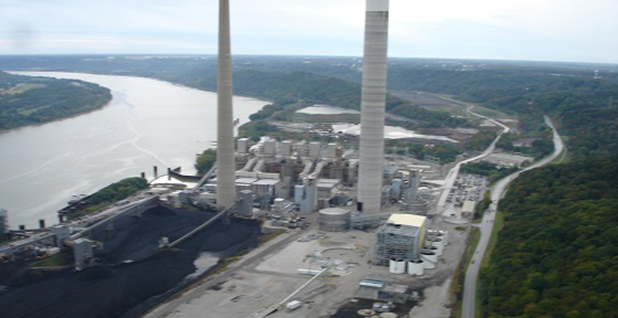Coal Industry Hands Another Rescue Plan to DOE

By Dylan Brown
September 7, 2018 - The Trump administration today received the second coal rescue plan in as many days from an industry-led panel.
The National Coal Council’s “Power Reset” lays out steps the industry hopes will “stem the tide” of retirements of coal-fired power plants.

Kyger Creek Generating Station is a coal-fired power plant in Cheshire, Ohio.
Photo by Ohio Valley Electric Corporation
The Department of Energy advisory panel’s report comes on the heels of another report, “Advancing U.S. Coal Exports,” given to Energy Secretary Rick Perry yesterday.
Today’s report was compiled by a subcommittee led by Glenn Kellow, CEO of Peabody Energy Corp., the nation’s top coal company; Paul Sukut, CEO of Basin Electric Power Cooperative, a coal-reliant power company; and Matt Rose, executive chairman of BNSF Railway Co., which derives a fifth of its revenue from coal.
While exports have surged, 82 percent of American coal was still burned at American power plants last year, according to the U.S. Energy Information Administration.
With President Trump’s pledge to save coal looming large, Perry has loaded DOE’s table with options for coal’s rescue after the Federal Energy Regulatory Commission rejected his proposed coal and nuclear plant subsidy.
The DOE coal council argued coal-fired power plants need to be compensated for grid resilience and reliability — the industry’s buzzwords in its struggle against grid operators and utilities that are rapidly converting to natural gas and renewable fuel sources.
But first, the report says, the value of coal plants must be quantified.
The council recommends creating a standard definition and quantitative metrics for “grid resilience,” while assessing grid operators’ concerns about fuel security and how moving away from coal has affected other countries.
“Acknowledge the significant and disproportionate impact on the existing U.S. coal fleet of market distortions, over-regulation and regulatory uncertainty,” the council recommended. “Acknowledge the explicit economic, dispatchable and grid-resilient value provided by the existing U.S. coal fleet.”
The report then calls for a series of “market reforms.” Most involve the White House backing FERC actions, including capacity market reforms, electricity price formation refinements, reliability standards and resilience assessments.
The coal council also calls for regulatory reforms, most of which are underway, including EPA’s new Affordable Clean Energy rule, the replacement for the Obama-era Clean Power Plan, and an overhaul of the Clean Air Act’s New Source Review rules governing emissions from new and modified power plants.
EPA is also rewriting regulations on coal ash and effluent limitation guidelines.
The council’s report supports updating those regulations as well as the 1978 Public Utility Regulatory Policies Act.
The council also outlines a series of tax reforms, including temporary tax credits for operating and maintenance expenses for existing coal plants and additional incentives to get more coal plants to use tax credits designed to encourage development of carbon capture, sequestration and utilization (CCUS) projects.

